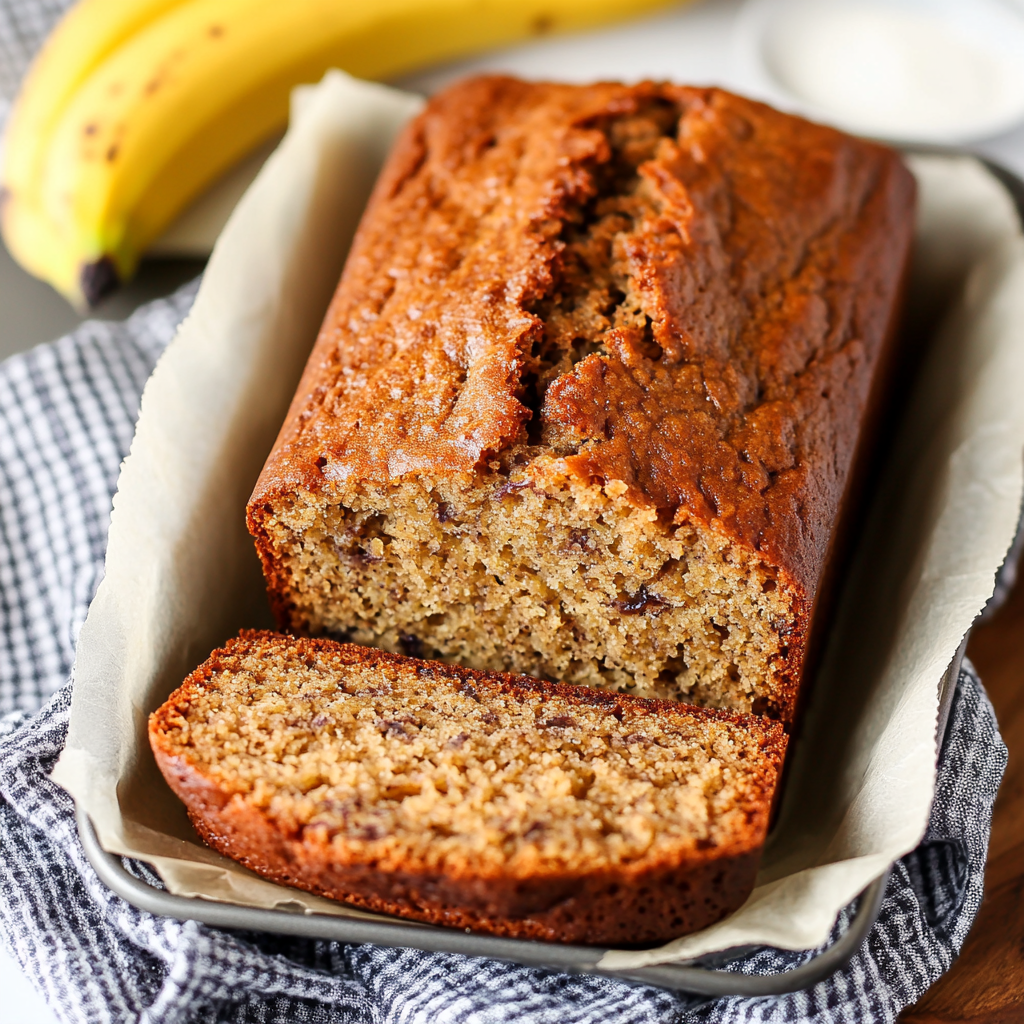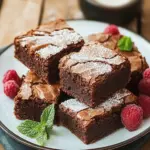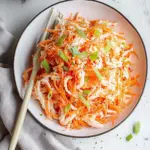This one-bowl banana bread is a no-fuss, all-flavor classic that belongs in every home baker’s recipe box. With just a few pantry staples and ripened bananas, you’ll create a tender, moist loaf that fills your kitchen with the warm scent of nostalgia.
Perfect for breakfast, snacking, or even dessert, this banana bread is a breeze to whip up. No mixers, no complicated steps—just stir, pour, bake, and enjoy. Serve it plain, add nuts or chocolate chips, or slather on some butter for an irresistible treat.
Full Recipe
Ingredients:
-
3 ripe bananas, mashed
-
1/3 cup melted butter
-
3/4 cup sugar
-
1 egg, beaten
-
1 teaspoon vanilla extract
-
1 teaspoon baking soda
-
Pinch of salt
-
1 1/2 cups all-purpose flour
Directions:
-
Preheat your oven to 350°F (175°C).
-
In a large mixing bowl, mash bananas until smooth.
-
Stir in melted butter until well combined.
-
Mix in the sugar, beaten egg, and vanilla extract.
-
Sprinkle baking soda and salt over the mixture and stir in.
-
Add the flour and mix just until incorporated—do not overmix.
-
Pour batter into a greased 4×8 inch loaf pan.
-
Bake for 50-60 minutes or until a toothpick inserted into the center comes out clean.
-
Let cool in the pan for a few minutes before transferring to a wire rack.
Prep Time: 10 minutes | Cooking Time: 55 minutes | Total Time: 1 hour 5 minutes
Kcal: 210 kcal per slice | Servings: 10 slices
The History and Charm of Banana Bread
Banana bread has long been a beloved staple in kitchens around the world, known for its comforting aroma and moist, tender crumb. The origins of banana bread date back to the early 20th century, when baking soda and baking powder became more widely available to home bakers. These leavening agents allowed cooks to create quick breads that didn’t require yeast or long rising times, revolutionizing baking and enabling treats like banana bread to flourish.
At its core, banana bread is a simple recipe made to use overripe bananas that might otherwise be discarded. This frugal and clever use of ripe fruit has contributed to the bread’s enduring popularity. Over the decades, it has evolved from a basic loaf into countless variations with nuts, chocolate chips, spices, or even swirls of peanut butter and caramel. Yet the classic, simple one-bowl banana bread remains a favorite for its ease and consistent deliciousness.
Why One-Bowl Banana Bread?
The one-bowl banana bread method is especially appealing because of its simplicity and minimal cleanup. This recipe is designed so that everything — mashed bananas, melted butter, sugar, eggs, flour, and baking soda — is combined in a single bowl. There is no need for extra bowls, mixers, or complicated equipment, which makes it ideal for beginners or anyone short on time.
Beyond convenience, this method encourages gentle mixing, which is important for maintaining the bread’s moist texture. Overmixing quick bread batter can lead to dense or tough results because it develops gluten in the flour. Stirring just until the ingredients come together ensures a light, tender crumb and a perfectly soft texture that melts in your mouth.
The Science Behind the Moisture and Flavor
Banana bread’s signature moistness comes from several factors working in harmony. The bananas themselves contribute natural moisture and sweetness, while the melted butter adds richness and tenderizes the crumb. Sugar, aside from sweetening, also helps retain moisture and improve texture.
The chemical reaction triggered by baking soda when combined with acidic ingredients — like bananas — causes the batter to rise and become airy. This leavening action is critical for the light structure that distinguishes banana bread from a dense loaf cake.
Additionally, the natural sugars in bananas caramelize during baking, creating a golden crust and deep, complex flavors. This contrast between the soft interior and slightly crisp crust is a hallmark of a well-made banana bread.
Customization and Variations
One of the most fun aspects of banana bread is how versatile it is. You can customize the recipe to suit different tastes and dietary needs with ease.
-
Add-ins: Nuts such as walnuts or pecans add crunch and nuttiness. Chocolate chips bring bursts of sweetness and richness. Dried fruits, like cranberries or raisins, offer a chewy texture and tart contrast.
-
Spices: Cinnamon, nutmeg, or allspice introduce warm, aromatic notes that complement the bananas beautifully.
-
Flours: For gluten-free or whole grain options, alternative flours like almond flour, oat flour, or whole wheat can be swapped in, though texture may vary slightly.
-
Sweeteners: Honey, maple syrup, or coconut sugar can replace granulated sugar to introduce different flavors and adjust sweetness.
-
Dietary swaps: Using plant-based milk and egg substitutes allows for vegan banana bread that still tastes indulgent.
Experimenting with these variations allows you to make the recipe uniquely your own or adapt it for special occasions.
Health Benefits of Banana Bread
While banana bread is often considered an indulgent treat, it does have some redeeming nutritional qualities when made with wholesome ingredients. Bananas themselves are rich in potassium, vitamin C, vitamin B6, and dietary fiber, which contribute to heart health, digestion, and overall wellbeing.
By using ripe bananas, this bread naturally contains some sweetness, allowing for reduced added sugar compared to other desserts. When paired with nuts, it gains healthy fats and protein, which can help with satiety.
However, as with any baked good, moderation is key. Banana bread should be enjoyed as part of a balanced diet. Choosing whole grain flours or adding extra fiber can also increase its nutritional value.
Tips for Perfect Banana Bread Every Time
To get the best results from your banana bread, here are some helpful tips:
-
Use very ripe bananas: The riper the bananas, the sweeter and more flavorful the bread will be. Look for bananas with plenty of brown spots or even fully brown skins.
-
Do not overmix: Stir ingredients just until combined to avoid developing gluten and creating a tough loaf.
-
Check your baking time: Ovens vary, so start checking the bread around 50 minutes by inserting a toothpick. If it comes out clean or with a few moist crumbs, the bread is done.
-
Let it cool: Allowing the bread to cool in the pan for about 10 minutes before removing it prevents it from breaking apart and helps set the crumb.
-
Store properly: Keep banana bread wrapped in plastic or in an airtight container at room temperature for 2-3 days, or freeze for longer storage.
Perfect Occasions for Banana Bread
Banana bread is incredibly versatile and fits many occasions perfectly. It makes a wonderful breakfast served warm with butter or cream cheese. It’s an ideal snack for kids’ lunchboxes or afternoon tea. It also works well as a casual dessert paired with ice cream or a drizzle of honey.
Because it stores well, banana bread is often baked ahead of time for holiday gatherings, potlucks, and brunches. Its comforting, familiar flavor appeals to all ages, making it a crowd-pleaser wherever you serve it.
Conclusion
Banana bread is more than just a simple baked good — it’s a timeless classic that brings warmth and joy to any kitchen. The beauty of the one-bowl method lies in its accessibility, letting both novice and seasoned bakers create a moist, flavorful loaf with minimal effort and mess.
With ripe bananas as its star ingredient, banana bread embodies resourcefulness and comfort. Its versatility invites endless customization, ensuring this recipe never grows old. Whether enjoyed fresh from the oven or toasted the next day, banana bread remains a symbol of homey goodness and simple pleasures.
So, gather your ripe bananas, grab a bowl, and bake up a loaf of this sweet, tender bread that never fails to brighten the day. It’s the perfect treat to savor anytime — easy, satisfying, and utterly delicious.






